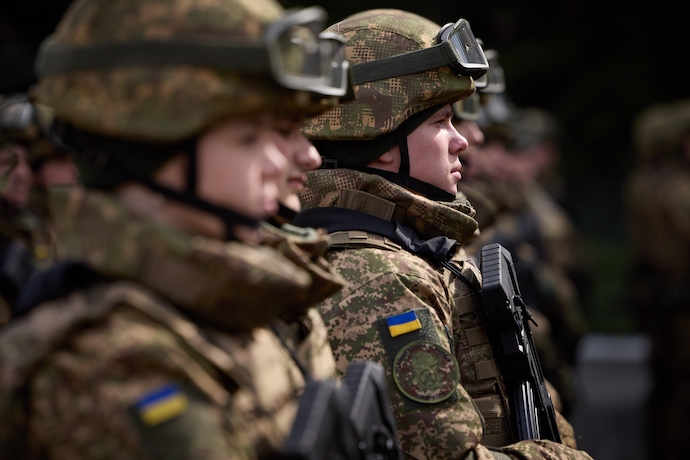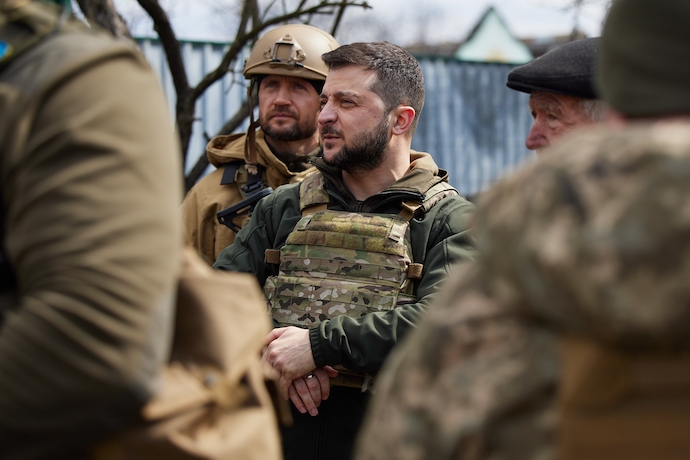
How Saving Ukraine Will Make America Stronger
The world is entering its most perilous phase since the end of the Cold War. Major powers are testing the boundaries of the current global security order: Russia pushes deeper into Ukraine, Iran foments instability across the Middle East, and China casts its gaze toward Taiwan.
Although the United States remains, on paper, the world’s most powerful military force, it is—strategically—lagging. This is not due to a lack of funding or manpower but rather a failure to absorb the hard-won lessons of the most important military innovation laboratory in the world today: Ukraine.
As a Ukrainian drone operator currently stationed on the front lines, we have seen firsthand how Ukraine is rewriting the rules of modern warfare. Supporting Ukraine is not merely about ensuring its survival, nor is it essential solely to Baltic and broader European security. Helping Ukraine will make the United States stronger, smarter, more secure, and more prepared for a future in which warfare is being rapidly and radically redefined.
This is not a moral plea. It is a strategic argument. The future of warfare is unfolding in real-time in Ukraine.

Over the past year, the United States produced roughly 100,000 drones. Ukraine? More than 2.5 million. That statistic alone should raise alarm bells in Washington.
Ukrainian units now deploy low-cost drones equipped with AI-assisted targeting systems capable of striking with extraordinary precision—at a fraction of the cost of conventional weapons. These drones, which cost between $300 and $500, are disabling systems worth over $200,000, including tanks and air defenses.
At a recent talk at the Ukrainian Catholic University, Valerii Zaluzhnyi, Ukraine’s ambassador to the UK, remarked that Ukrainian drones are outperforming U.S.-made Javelins in battlefield effectiveness—for a price tag nearly 400 times lower. An officer from Ukraine’s Security Service noted how Ukrainian naval drones forced the Russian Black Sea Fleet to retreat from Sevastopol—effectively neutralizing Russian naval control with what are, in essence, remote-controlled jet skis.
This isn’t the future. This is now.
There’s an old adage: unprepared nations and outdated defense strategies end up fighting the last war. This is painfully true for the United States, which continues to spend billions on carrier strike groups and legacy systems. Even if America no longer places NATO or European security at the center of its strategic interests, it must quickly internalize the lessons being forged on Ukrainian soil—or it will find itself unprepared for future conflicts against adversaries deploying methods and technologies for which the U.S. lacks adequate defenses.
Among the clearest lessons from America’s defeats in Vietnam and Afghanistan is the high cost of failing to adapt to the terrain and tactics of unconventional enemies. All the expensive bombs and bullets deployed in those wars did not lead to victory.

Ukraine is not simply innovating—it is battle-testing and validating the effectiveness of American-made weapons systems. Tools like the Patriot missile, HIMARS, and Javelins haven’t just been deployed in theory—they have been tested under maximum pressure against a near-peer adversary. While the U.S. may still lead the world in developing advanced weapons, it no longer leads in their application or scalable deployment. This mirrors earlier patterns in consumer technology, where Japan, and later China, took American innovations and outperformed the U.S. at its own game through superior mass production.
Kyiv is arguably the most well-defended city from aerial attack in modern military history, due in large part to American air defense systems and Ukraine’s ingenuity in integrating them. When these weapons succeed in Ukraine, they don’t merely save lives—they build trust and credibility. And credibility sells. The U.S. could affix a “battle-tested in Ukraine” label on these systems and command significantly higher prices in an increasingly security-conscious global market.
To maintain its edge in global arms sales, the United States must understand that a Ukrainian victory is a critical marketing asset. Conversely, if Ukraine loses, American-made systems lose prestige, and prospective buyers may turn to other producers or invest in domestic alternatives. This shift is already underway in parts of the European Union.
So why is the U.S. still entertaining policies that limit or compromise its defense exports? Why are there whispers about “F-35 kill switches” that sow mistrust among allies?
Rather than treating Ukraine solely as a recipient of aid, the United States should embrace it as a strategic partner. Co-develop next-generation weapons. License Ukrainian drone innovations. Invest in battlefield-proven startups such as UkrSpecSystems or DeViRo. Build joint production lines and share in royalties or technology IP. It’s not just sound economics—it’s smart defense policy. Many Ukrainian defense firms are open to such partnerships because Ukraine’s survival hinges on innovation. That’s a deal worth making.
No other country possesses Ukraine’s level of combat experience.
On average, Ukraine must respond to 3,000 significant aerial threats each month across a territory the size of Texas. Some threats take the form of low-cost Iranian drones carrying 50 kilograms of explosives. Others are cruise or hypersonic missiles. Some can be brought down with machine guns; others require billion-dollar Patriot systems.
Due to limited resources, Ukraine was forced to develop a multi-tiered air defense network designed for cost-efficiency. Now, imagine firing 3,000 Patriot missiles monthly—an unsustainable $12 billion price tag. Not even the United States could afford that.
If Donald Trump or any U.S. leader seeks to develop a Star Wars or Iron Dome air defense system, there is much to be learned from Ukraine’s decentralized and adaptable model.
Ukraine survives this war not through superior firepower but by building an ecosystem of rapid learning, tactical innovation, and distributed defense. This isn’t a matter of inherent brilliance—it is a matter of survival. The same dynamic is at work in the Baltic states, where conventional defense doctrines are being replaced by strategies emphasizing hybrid warfare and democratic resilience.
A joint venture between the United States and Ukraine could formalize this expertise through a Ukrainian Instructor Corps overseen by the U.S. military.
Veterans with real-world knowledge of modern drone tactics, trench warfare, close-quarter combat, electronic countermeasures, and layered defense strategies could train NATO and American forces. It’s a mutually beneficial arrangement: America helps Ukraine survive; Ukraine trains America for the next war.

What happens if Ukraine falls?
This scenario isn’t abstract—it is one we think about constantly in Ukraine and across the Baltics. If Kyiv falls, if most of the country is occupied, one of us will be executed for being “too Ukrainian.” Others—officers, veterans, civilian specialists—will be pressed into service by Russia, their combat experience turned against the West. They will be mobilized for Russia’s next war.
And that war will not stop at Ukraine’s borders. It will breach the Suwałki Gap, destabilize the Baltics, and land at NATO’s doorstep. This is not a dramatic exaggeration—RAND studies on Russian war planning in the Baltics indicate NATO may be unable to repel a Russian advance in time.
America is only as powerful as its alliances. A fractured Europe, contrary to what Donald Trump believes, will not make America great again. Broken alliances, outdated weapons, and a reputation already damaged by the chaotic Afghanistan withdrawal would only further isolate the United States.
A Russia that absorbs Ukraine is far more dangerous than a Russia that fails. Failing to stop Putin now—when the cost is measured in tens of billions—means paying hundreds of billions later, possibly in American lives.
The United States doesn’t need to choose between defending democratic values and protecting its strategic interests. The current moment presents a rare opportunity to accomplish both—by helping Ukraine win.

